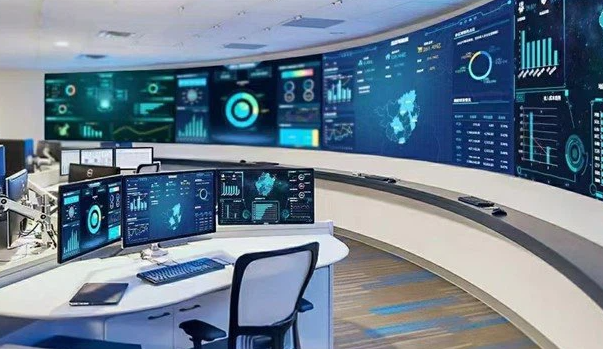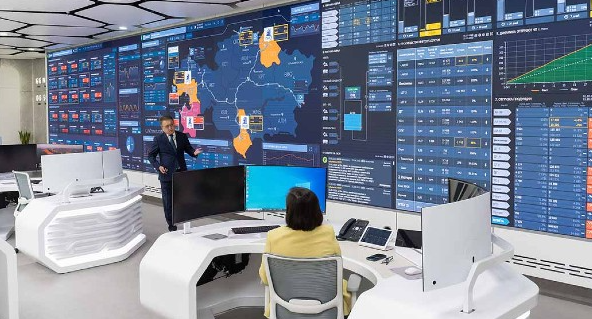A control room is a centralized space where monitoring, control, and coordination of various systems and processes take place. It serves as the nerve center for managing critical operations and ensuring the smooth functioning of various facilities. Control room operators need access to real-time visual analytics that are optimized for clarity and comprehension. Therefore, a clear and organized presentation of relevant information is crucial to the proper functioning of the control room. High definition LED displays provide sharp and clear information that enhance the awareness of the operators and empower their decision-making. That’s why LED displays are popular in control rooms. Let’s dive into the details.

Control rooms take part in difference application scenarios, from military operations to emergency management, and from space flight control to traffic stations, etc. Control rooms have some common features and functions like below.
Monitoring and Surveillance: Control rooms are equipped with an array of displays, including video walls, LED screens, or computer monitors, to provide real-time visual feedback from surveillance cameras, sensors, or other monitoring devices. Operators can closely monitor activities, detect anomalies or issues, and take appropriate actions.
Process Control: Control rooms are commonly used in industrial settings, such as power plants, manufacturing facilities, or transportation networks, to monitor and control complex processes. Operators oversee and manage equipment, machinery, and systems to maintain optimal performance, efficiency, and safety.
Communication and Collaboration: Control rooms facilitate communication and collaboration among operators and team members involved in managing operations. They provide tools like intercom systems, radios, or collaboration software to enable seamless information sharing and coordination.
Emergency Response: Control rooms play a vital role in emergency situations, such as natural disasters, security incidents, or critical events. Operators receive and process emergency alerts, initiate response protocols, coordinate resources, and communicate with relevant stakeholders to mitigate risks and ensure public safety.
Alarm Management: Control rooms handle alarms and notifications generated by various systems and devices. Operators prioritize and respond to alarms promptly, investigating any potential issues and taking appropriate actions to resolve or escalate them as needed.
Decision Support: Control rooms are equipped with advanced technologies, such as data analytics, predictive modeling, or AI-based systems, to provide operators with decision support tools. These tools analyze data and provide insights, recommendations, or automated actions to optimize operations or address potential issues.
Ergonomics and Operator Comfort: Control rooms are designed to provide a comfortable and ergonomic environment for operators who may need to work extended shifts. Factors like lighting, temperature control, adjustable furniture, and ergonomic consoles contribute to operator well-being and productivity.
Redundancy and Resilience: Control rooms incorporate redundancy and backup systems to ensure continuous operation and minimize downtime. This includes redundant power supplies, backup data storage, duplicate displays, or fail-over mechanisms to maintain critical operations during equipment failures or emergencies.
Integration and System Interoperability: Control rooms integrate multiple systems, technologies, and software platforms to provide a holistic view of operations. This includes integrating data from different sources, connecting various control systems, and facilitating interoperability between different software applications.

All functions of a control room rely on data and information visualization. A control room often employs visual displays, including graphs, charts, or dashboards, to present data in a clear and concise manner. This allows operators to quickly grasp the status of operations, identify trends, or make informed decisions based on real-time and historical data. And high definition LED displays helps and provides impeccable advantages like below.
High Visibility: LED displays offer high brightness levels, ensuring clear visibility even in well-lit control room environments. This quality is crucial for operators who need to monitor multiple sources of information simultaneously.
Large Display Area: Control rooms often require large display areas to accommodate multiple data feeds, video feeds, or graphical representations of complex systems. LED displays can be seamlessly tiled together to create a video wall with a large and continuous viewing area, allowing operators to have a comprehensive overview of the monitored processes.
Flexibility and Scalability: LED displays can be customized to fit the specific requirements of the control room. They are available in various sizes and aspect ratios, allowing for flexible configurations and scalability. LED displays can be easily expanded or reconfigured as the needs of the control room evolve over time.
High Resolution: LED displays offer high-resolution capabilities, enabling operators to view detailed information without compromising image quality. This is especially important when dealing with intricate diagrams, maps, or data visualizations that require precision and clarity.
Fast Refresh Rates: LED displays have fast refresh rates, ensuring smooth and fluid motion when displaying live video feeds or dynamic content. This is essential for control rooms that require real-time monitoring of video surveillance, live broadcasts, or rapidly changing data.
Reliability and Longevity: LED displays are known for their durability and long lifespan. They are designed to operate continuously for extended periods without significant degradation in performance. This reliability is crucial in control rooms where uninterrupted operation is essential.
Energy Efficiency: LED displays are energy-efficient compared to traditional display technologies. They consume less power while delivering high brightness levels, reducing overall energy costs for the control room.
Wide Viewing Angles: LED displays offer wide viewing angles, ensuring that operators can view the displayed content clearly and accurately from various positions within the control room. This is important in large control rooms where operators may be positioned at different viewing angles.
Content Flexibility: LED displays can handle a wide range of content types, including text, images, videos, and dynamic data visualizations. This versatility allows control room operators to display diverse information simultaneously, making it easier to monitor and analyze critical data.
Integration Capabilities: LED displays can integrate with various control room systems and software, enabling seamless connectivity and data integration. This integration allows operators to display real-time data from different sources, such as surveillance cameras, monitoring sensors, or software applications, on the LED display for centralized monitoring and control.

Kinglight offers various mini and micro LEDs for high defintion LED display manufacturing
Overall, LED displays provide control room operators with a powerful visualization tool that enhances situational awareness, facilitates decision-making, and improves overall efficiency in managing critical operations.